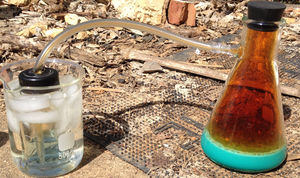Nitrogen dioxide
 Nitrogen dioxide(right) being generated by the reaction of copper metal with nitric acid.
| |
| Names | |
|---|---|
| IUPAC name
Nitrogen dioxide
| |
| Other names
Deutoxide of nitrogen
Nitrogen(IV) oxide | |
| Properties | |
| NO2 | |
| Molar mass | 46.0055 g/mol |
| Appearance | Reddish-brown gas |
| Odor | Poignant, unpleasant Car exhaustion-like |
| Density | 1.88 g/l |
| Melting point | −11.2 °C (11.8 °F; 261.9 K) |
| Boiling point | 21.2 °C (70.2 °F; 294.3 K) |
| Reacts giving nitric acid and nitric oxide | |
| Solubility | Reacts with alcohols Soluble in carbon tetrachloride, chloroform, nitric acid |
| Vapor pressure | 98.80 kPa (at 20 °C) |
| Thermochemistry | |
| Std molar
entropy (S |
240 J·mol-1·K-1 |
| Std enthalpy of
formation (ΔfH |
34 kJ/mol |
| Hazards | |
| Safety data sheet | Sigma-Aldrich |
| Flash point | Non-flammable |
| Lethal dose or concentration (LD, LC): | |
| LC50 (Median concentration)
|
30 ppm (guinea pig, 1 hr) 315 ppm (rabbit, 15 min) 68 ppm (rat, 4 hr) 138 ppm (rat, 30 min) 1000 ppm (mouse, 10 min) |
| Related compounds | |
| Related compounds
|
Nitric oxide Dinitrogen tetroxide Dinitrogen pentoxide |
| Except where otherwise noted, data are given for materials in their standard state (at 25 °C [77 °F], 100 kPa). | |
| Infobox references | |
Nitrogen dioxide is inorganic compound, one of several oxides of nitrogen, with chemical formula NO2. It is an acutely toxic reddish-brown gas with a sharp smell and is a potent oxidizer. It is often utilized in the production of nitric acid.
Contents
Properties
Chemical
Contact between nitrogen dioxide and organic compounds(such as some plastics) can result in explosions, arising from its highly oxidative properties. The dissolution of nitrogen dioxide in water produces nitric acid along with short-lived nitrous acid. A higher yield of nitric acid is obtained if nitrogen dioxide is instead passed into hydrogen peroxide, though neither of these methods is the most efficient for producing nitric acid. Nitrogen dioxide can also be used to produce nitrate salts by passing it over a metal oxide.
Nitrogen dioxide is at equilibrium with dinitrogen tetroxide containing about 12% nitrogen dioxide and 88% dinitrogen tetroxide at standard conditions.
Physical
Nitrogen dioxide appears as an amber-colored gas. It presents a very unique pungent odor in low concentrations, such as during its emission in car exhaust, but at high concentrations has a much sharper smell often accompanied by a painful or prickling sensation in the nose. Nitrogen dioxide boils at 21.2 °C and melts at −11.2 °C. It will react with water in the presence of an oxidizer to produce nitric acid. It is however, soluble in carbon tetrachloride and chloroform. Nitrogen dioxide is denser than air, and may accumulate in low areas without air flow.
Availability
Nitrogen dioxide must typically be produced in a lab setting, rather than purchased.
Preparation
Nitrogen dioxide is readily produced by reacting nitric acid with a number of metals, most notably copper, in a highly exothermic reaction, or by reacting a nitrate salt with hot or concentrated strong acids. It is also produced as a side-product of nitrations or when nitric acid is heated to the point of decomposition. Experiments involving the production of this gas should always be done in a reliable fume hood or outside.
Projects
- Make your own nitric acid
- DMSO synthesis
- Dinitrogen tetroxide synthesis
- Anhydrous metal nitrates
Handling
Safety
Nitrogen dioxide is quite toxic and overexposure can lead to permanent injury or even death. Inhalation should always be kept to a minimum, and it is best to conduct experiments with nitrogen dioxide in a fume hood or outside and at a distance. Above certain concentrations in air, nitrogen dioxide anesthetizes the nose, making its detection by smell nearly impossible. Nitrogen dioxide readily attacks many kinds of plastics, including tubing, and can cause fires and explosions in this manner.
Storage
Nitrogen dioxide should only be stored when needed to perform a reaction and only for short periods of time. Since it boils at 21.2 °C, it is very easy to liquefy and can be stored in thick ampoules for display. However, due to its hazards, it's better to not store a larger quantity and should be made in situ when needed.
Disposal
Nitrogen dioxide can be neutralized by bubbling it through an alkali solution.